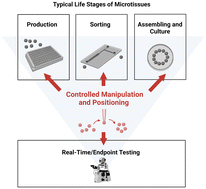Tools for manipulation and positioning of microtissues
Abstract
Complex three-dimensional (3D) in vitro models are emerging as a key technology to support research areas in personalised medicine, such as drug development and regenerative medicine. Tools for manipulation and positioning of microtissues play a crucial role in the microtissue life cycle from production to end-point analysis. The ability to precisely locate microtissues can improve the efficiency and reliability of processes and investigations by reducing experimental time and by providing more controlled parameters. To achieve this goal, standardisation of the techniques is of primary importance. Compared to microtissue production, the field of microtissue manipulation and positioning is still in its infancy but is gaining increasing attention in the last few years. Techniques to position microtissues have been classified into four main categories: hydrodynamic techniques, bioprinting, substrate modification, and non-contact active forces. In this paper, we provide a comprehensive review of the different tools for the manipulation and positioning of microtissues that have been reported to date. The working mechanism of each technique is described, and its merits and limitations are discussed. We conclude by evaluating the potential of the different approaches to support progress in personalised medicine.



 Please wait while we load your content...
Please wait while we load your content...